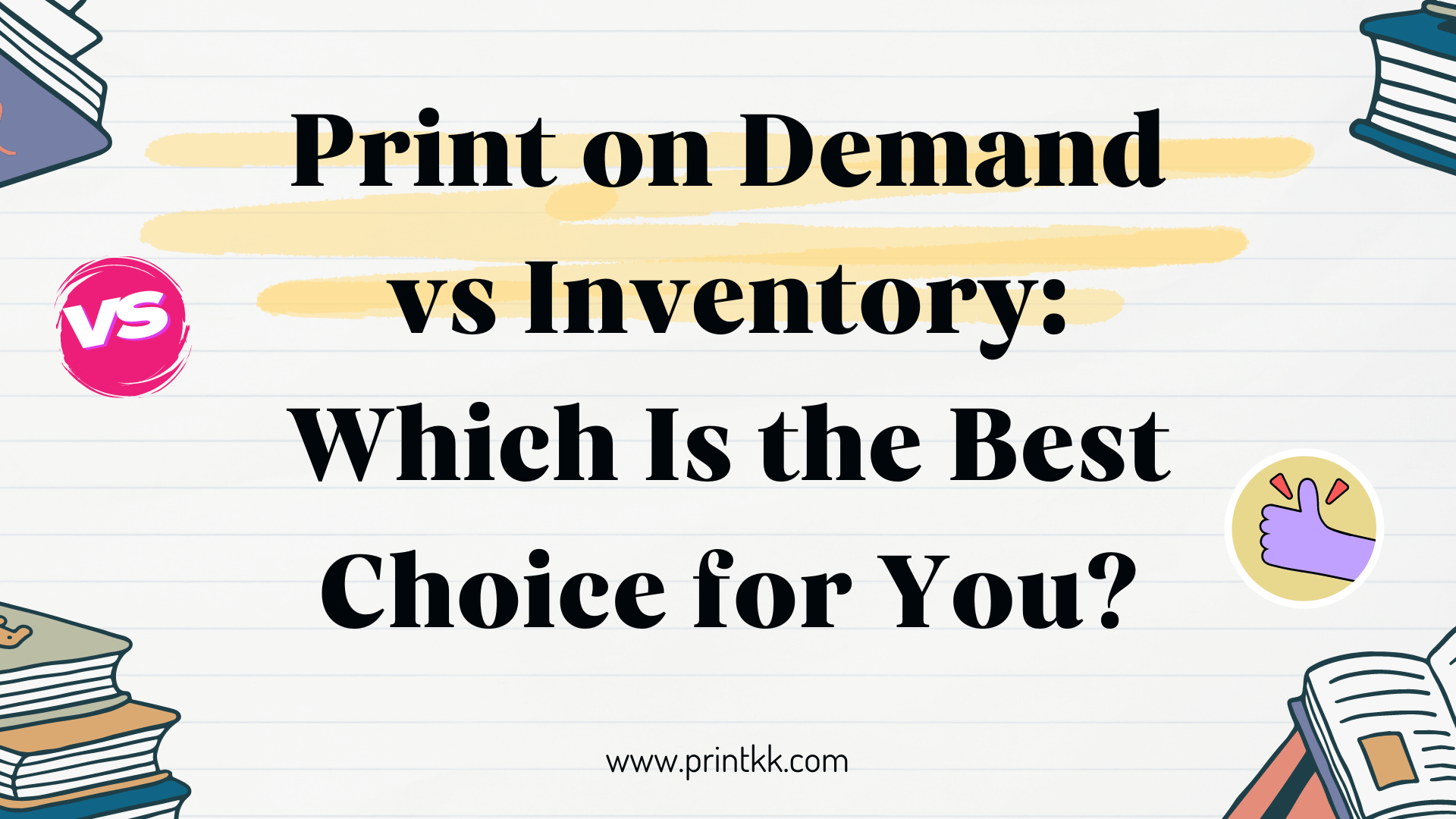
Aspiring to start an online store but uncertain about handling stock? Indecision could cost you opportunities or leave you grappling with overstocked shelves or stockouts. Don't fret! We're here to unveil the pros and cons of two popular models, empowering you to make an informed choice. Whether you crave flexibility or control, there's a perfect solution waiting for you. Prepared to begin your journey towards achievement? Let's explore together and give your e-commerce dreams the wings they need to soar!
What Is the Print on Demand?
Imagine transforming your creative concepts into tangible products without the burden of inventory management or initial expenses. That's the allure of Print on Demand (POD)! This innovative business model enables you to design custom items and sell them on a wide range of products, such as t-shirts and home decor, all without handling the inventory yourself.
POD operates by linking you with suppliers who manage the printing, packaging, and shipping of your products. When a customer makes a purchase, the item is created and shipped directly to them. This streamlined process removes the need for storage space and minimizes financial risk, making it an appealing choice for both budding entrepreneurs and established brands.
One of the most thrilling aspects of POD is its flexibility. You can experiment with various designs, products, and markets without needing to commit to large quantities. This freedom allows you to test ideas swiftly and adapt to evolving trends, providing you with a competitive advantage in the dynamic world of e-commerce.
Ready to dive into the world of Print on Demand? With low barriers to entry and endless creative possibilities, it's an opportunity worth exploring. Whether you're an artist looking to monetize your work or a business owner seeking to expand your product line, POD offers a pathway to turn your vision into reality.
Pros & Cons of Print on Demand
| Pros | Cons |
| Low initial investment | Lower profit margins per item |
| No inventory management | Limited control over product quality |
| Quick product launches | Longer shipping times |
| Easy scalability | Restricted customization options |
| Minimal risk | Dependence on third-party suppliers |
| Wide product range | Potential for inconsistent print quality |
| No need for storage space | Less branding control on packaging |
| Ability to test designs easily | Higher per-unit costs |
| Global fulfillment options | Limited ability to bundle products |
| Automation of order processing | Possible printing errors |
What Is the Inventory?
Running out of stock during a sales boom or being left with unsold products can be a nightmare for any business. These scenarios highlight the critical role of inventory management in the success of your venture. But what exactly is inventory?
Inventory pertains to the items and supplies a company keeps for the purpose of selling or manufacturing. It's the lifeblood of retail and manufacturing operations, representing a significant investment and potential for profit. Handling inventory can be a complicated balancing act, necessitating meticulous planning and predicting to satisfy customer needs while keeping costs low.
The challenges of inventory management can keep business owners up at night. Excess inventory locks up funds and risks items becoming outdated, while insufficient stock results in missed sales and unhappy customers. Fluctuating demand, seasonal trends, and supply chain disruptions further complicate the equation, making inventory decisions a constant source of stress.
Enter modern inventory management systems - the solution to these inventory woes. These tools utilize data analytics and live tracking to optimize inventory levels, forecast demand, and simplify ordering processes. By adopting efficient inventory strategies, businesses can lower holding costs, boost cash flow, and increase customer satisfaction.
Excelling in inventory management can revolutionize your business operations. It enables you to quickly adapt to market shifts, take advantage of trends, and sustain a competitive advantage. With the proper strategy, inventory turns into not just a requirement, but a strategic asset that drives growth and profitability.

Pros & Cons of Having an Inventory
| Pros | Cons |
| Immediate order fulfillment | Upfront capital investment |
| Bulk purchasing discounts | Storage costs |
| Better quality control | Risk of obsolescence |
| Ability to offer customization | Insurance expenses |
| Faster shipping times | Inventory tracking complexity |
| Enhanced brand experience | Potential for overstocking |
| Flexibility in pricing strategy | Tied-up cash flow |
| Easier to manage seasonal demand | Need for physical space |
| Direct control over supply chain | Risk of damage or theft |
| Opportunity for in-person sales | Inventory valuation challenges |
Understand Differences: Print on Demand vs Inventory
The Inventory Dilemma
Before diving into print on demand, many businesses grapple with traditional inventory management. They invest heavily upfront, stockpile products, and hope for the best. This approach often leads to sleepless nights worrying about unsold stock, storage costs, and cash flow issues. The fear of making the wrong inventory decisions can paralyze growth and limit creativity.
The Print on Demand Revolution
Picture a scenario where you can provide an endless variety of products without the hassle of maintaining physical stock. Print on demand transforms this dream into reality. It enables businesses to design and sell personalized products without maintaining inventory. Orders are produced and shipped as they come in, eliminating the need for storage and reducing financial risk. This approach unlocks a world of opportunities for product experimentation and market testing.
Bridging the Gap
Print on demand serves as the bridge between the limitations of traditional inventory and the flexibility modern businesses crave. It addresses the pain points of upfront costs and storage while offering the benefits of customization and scalability. By leveraging print on demand, businesses can focus on design and marketing, leaving production and fulfillment to specialized partners. This change in strategy enables entrepreneurs to venture into new markets and product lines with minimal risk.
Operational Efficiency
With print on demand, operational efficiency reaches new heights. The era of manual inventory counts and intricate stock management systems is over. Now, businesses can automate their entire production process, from order receipt to delivery. This efficient method not only saves time but also minimizes the chance of human error. The outcome is a leaner, more agile business model that can swiftly respond to market trends and customer preferences.
Financial Freedom
Print on demand liberates businesses from the financial constraints of traditional inventory models. The capital that would typically be tied up in stock can now be invested in marketing, product development, or other growth initiatives. This financial flexibility allows businesses to scale more rapidly and explore new opportunities without the burden of unsold inventory weighing them down. It's a game-changer for startups and established brands alike, providing a safety net for product launches and market expansion.

Reddit Review:Print on demand vs Inventory
A user on Reddit asked this question:
r/smallbusiness
My initial plan was to start selling merch using print on demand. While it is cost effective and has lower risk, the ROI is pretty low, considering it is pricey to print one at a time. After talking to a friend who owned a shirt business before. He told me I should rethink my business, switch to an inventory and by doing so, I will save a lot of money and long term, my profit will be a lot higher. Taking to account that I don't have too much money to invest upfront. Maybe around 3K dollars. Longer term, I want to make this my primary income. Invest in great custom packaging and more.
So which one is it? I would love to hear your take on it. If you have any knowledge on the topic please comment, will be really appreciated.
Let's take a look at everyone's answers:
PoweRaider
If you are design focused then POD allows you to test a wide array of designs with little to no risk exposure. when a specific design starts selling decent quantities have that design bulk printed. YES, You make less per item POD but you end up having less accumulation of dead stock. Less loss.
No reason to hold a warehouse of 1000 designs in 6 sizes if only 10 designs sell in only 3 sizes at any degree of significant volume.
Your friend OWNED a shirt business....So did half the stoners I know...doesnt mean Id take business advice from them.
8uniqdesign
It is good to start the business from POD business model, this is to know that there is a demand of your shirt. Most of apparel business dead because of the shop rental is getting expensive, and nowadays people prefer to order more online, since they know their size.
Which Is the Best Choice for You?
Assessing Your Target Audience
Grasping the nature of your customer base is essential when choosing between Print on Demand (POD) and stock-based models.
Inventory-based models shine when serving a more consistent customer base with predictable preferences.If your audience expects immediate availability and appreciates consistent quality, stocking inventory might be the better choice.
POD excels in catering to niche markets or audiences with diverse tastes. It enables you to provide a broad array of designs without the danger of overproduction. This method is especially effective if your target market appreciates uniqueness and diversity.
Evaluating Your Design Cycle
The frequency of your design updates can significantly influence your choice.
Inventory-based models work well for businesses with timeless designs or slower design cycles. If your products have a longer shelf life and consistent demand, stocking inventory can lead to more efficient operations and potentially higher profits.
POD is ideal for businesses that thrive on constant innovation and frequent design changes. It allows you to keep your product line fresh and responsive to current trends without the worry of unsold stock. This model suits designers who enjoy creating new concepts regularly.
Read more:
Considering Geographic Factors
Your business location and target market geography play a role in this decision.
Inventory-based models, give you more control over shipping and can be more cost-effective for local or regional markets. If your customer base is concentrated in a specific area, maintaining your own inventory might lead to faster delivery times and improved customer satisfaction.
POD services often have printing facilities in various locations, which can reduce shipping times and costs for international customers. This model is advantageous if you're targeting a global audience or operating from a remote location.
Analyzing Your Cash Flow
Your financial situation and cash flow management preferences are important factors to consider.
POD requires minimal upfront investment, making it an attractive option for businesses with limited capital or those preferring to allocate funds to other areas like marketing or product development. It also minimizes the risk of locking up capital in unsold stock. Conversely, inventory-based models typically demand a substantial upfront investment but can result in higher profit margins over time. This strategy is appropriate for businesses with steady cash flow and the capability to invest in bulk buying.

Weighing Customer Experience
The overall customer experience should be a primary factor in your decision.
POD can provide a broader selection of products, enabling customers to locate precisely what they desire. It may involve longer processing times, which could impact customer satisfaction.
Inventory-based models typically provide faster shipping and more consistent product quality, which can enhance the customer experience. This approach is particularly beneficial if your target audience values quick delivery and reliability over extensive product variety.
Evaluating Long-Term Goals
Your long-term business goals should direct your decision between POD and inventory.
Inventory-based models, though less adaptable, can offer a reliable basis for establishing a recognizable brand with uniform quality. This approach aligns well with businesses aiming to establish themselves as industry leaders in specific product categories or those planning to open physical retail locations in the future.
POD provides flexibility and scalability, making it perfect for businesses aiming to quickly expand their product lines or penetrate new markets. It's well-suited for entrepreneurs who want to test various product ideas without significant financial risk.
Conclusion
Choosing between Print on Demand and inventory-based models is a pivotal decision that can significantly impact your business trajectory. Both methods provide distinct benefits, and the optimal choice ultimately hinges on your particular situation, objectives, and resources. POD excels in its adaptability, minimal upfront costs, and capacity to serve niche markets with varied designs. It's an excellent option for those seeking to test new ideas or maintain a broad product range without the risk of excess stock. On the flip side, inventory-based models excel in providing consistent quality, faster shipping times, and potentially higher profit margins for established products with steady demand.
When evaluating your options, take into account factors such as your target audience, design cycle, geographic reach, financial situation, and long-term objectives. Remember, success in either model hinges on understanding your market, delivering quality products, and providing exceptional customer service. Whichever path you choose, stay adaptable and open to evolving your strategy as your business grows and market conditions change. With careful consideration and strategic implementation, either approach can lead to a thriving and profitable venture in the dynamic world of e-commerce and custom products.
FAQs
Is print on demand more profitable?
Print-on-demand profitability varies depending on factors like product selection, pricing strategy, and marketing efforts, but it can be profitable with the right approach and low upfront costs.
Which business model should I pick for my online store?
The optimal business model for your online store will be determined by your specific goals, available resources, and target market.
Which business model can offer me with various products?
Print-on-demand can offer you a wide variety of customizable products without holding inventory.
Is Etsy or Shopify considered print-on-demand?
Neither Etsy nor Shopify are print-on-demand services themselves, but both platforms can be used to sell print-on-demand products.
How to be successful with print on demand?
Success in print-on-demand comes from creating unique designs, targeting the right audience, optimizing your marketing, and providing excellent customer service.










 Global Shipping
Global Shipping





























